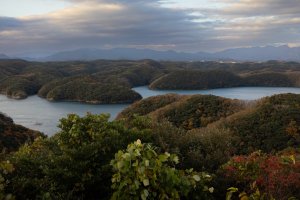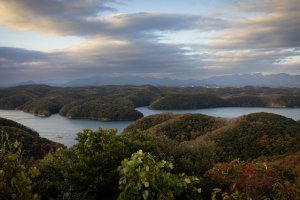Tsushima is one of Japan's Heritage sites in Nagasaki, offering a unique blend of culture and history. Situated between Kyushu and the Korean Peninsula, it has become a popular tourist destination among both Japanese and South Korean visitors. In fact, most signs on the island are displayed in both Japanese and Korean languages. Moreover, the island has been attracted by gamers around the world, influenced by the “Ghost of Tsushima," which was released in 2020.
Another captivating aspect is the island's association with the mythology of being one of the eight original islands created by the Gods– Izanagi and Izanami. The Tsusima Shrine Guidebook states that there are currently 29 shrines on the island, a considerable drop from the 455 religious structures that were documented during the Edo period.

Where is Tsushima?

Tsushima, an island closer to the Korean Peninsula than Japan's main island, serves as a gateway to discovering one of Japan's unique cultures.
The island spans about 82 km from its northern to southern ends, with approximately 90% covered by mountainous terrain and primeval forests. The vistas from the mountain peaks, such as the Eboshidake Observatory, offer astounding views, allowing glimpses of Korea's landscape.

Tsushima is believed to have been established around the Yayoi period—300 BCE to 250 CE—serving as a crucial trading center between the Korean Peninsula and Japan's main island. During the Edo era (1603-1868), Tsushima played a pivotal role in transferring cultural and technological knowledge to Edo–current Tokyo area–while providing military assistance to Korea.
According to the Tsushima Museum, Tsushima used to be so heavily fortified that the entire island was said to be "a fortress," with gun batteries all over the place. There were more than 30 of them. Because of the location of the island, dynamic ruins of such fortresses still remain today.


One of Tsushima's local residents shared, “It’s not common to speak Korean if you are born here as Japanese. We just try to be available for both languages because we equally have tourists from both nationalities.”
In July 1999, a high-speed ferry connecting South Korea’s Busan and Tsushima’s Hitakatsu port was inaugurated, significantly enhancing accessibility and boosting the local economy. Since then, South Koreans have been capable of traveling to Tsushima by just a 70 minute ride; the economy flourished due to travelers from the neighborhood.

With the epic transportation, sightseeing became more flexible and feasible for both domestically and internationally. The influx of South Korean tourists prompted the need for more guides, information in both Japanese and Korean to regulate certain Japanese laws.
Additionally, with the release of the video game "Ghost of Tsushima" in 2020, Tsushima gained more international attention from the gamers in the world. Some fans make guesses about a certain historical site in the real world.


Discovering Tsushima's Local Culinary Marvels
Exploring ethnic food and local agriculture adds a fascinating dimension to travel. Similar to learning a new language, trying ethnic local cuisine is exploring its agriculture and background.
Here are the lists which are renowned for several culinary delights:
- Anago a.k.a Japanese salt-water eels,
- Tsushima’s Honey,
- Rokube noodle from sweet potato,
- Tonchan-yaki.
1. Anago (Japanese Saltwater Eels)
As an island surrounded by the ocean, Tsushima excels in fisheries. The locally branded Golden Eel, known for its thickness and chewiness, is a must-try. When it comes to Japanese saltwater eels, other prefectures such Hiroshima and Shimane are the notable regions to picture it. Whilst Tsushima has its own brand, Golden Conger Eel (Kogane Anago in Japanese) captivates tourists from all over the world. Personal recommendation: Anago tempura, crispy and devoid of a strong fishy odor. Others are; Anago in a bamboo steamer and grilled eels at Anaga Tei.

2. Tsushima’s Honey
Tsushima is notable for producing exceptional honey with precious wild Japanese bees. Hachi-dou, traditional log-carved hives, are placed in the mountains to naturally collect honey from a diverse range of flowers. The taste is genuinely gentle compared to other basic honey products. Harvesting this honey requires significant effort, reflecting in its cost. Its extravagance makes it a delightful complement to any kind of bread or when paired with a cup of coffee. This is the sole location to obtain authentic honey produced by wild Japanese bees.

3. Rokube Noodle from Sweet Potato
A unique Tsushima noodle dish made from sweet potato starch, Rokube noodles originated during the Edo period. Due to geological processes, Tsushima ancient people invented the noodles from sweet potatoes and were an excellent plant that could adapt to the rocky, barren land of Tsushima. A method was devised to extract the starch (called "sen") from the sweet potato through a complex process of soaking it in water and fermenting it, making it possible to preserve it for a long time.
This is one of the healthy and easy-to-eat soup noodles. If you have eaten Konjac, the texture and appearance are similar to it.

4. Tonchan-yaki
A regional cuisine influenced by South Korea—Tonchan-yaki–featuring marinated pork with miso, garlic, and spices, is widely available in the upper part of Tsushima. “Tonchan" is a dish that mainly uses pigs’ offal, but "Kami-Tsushima Tonchan" is a little different, as it uses the normal part of pork itself. This Tsushima tonchan-yaki, also called "Soul food" or “Seoul food” in Japanese, has spread from the northern Tsushima area and is notable to serve on the menus of almost all restaurants in the Kami-Tsushima region.
Activity

For an intriguing and memorable accommodation experience, consider staying at Seizanji Temple. The temple is available in Japanese, Korean and English and welcomes international seekers. Situated on top of a hill brings tranquility and peaceful moments. Especially, at night, the area becomes dead silent and twinkling stars in the sky.


Tsushima emerges as a cultural gem, seamlessly blending history, cultural diversity, and natural splendor. The island's unique fusion of Japanese and Korean influences, showcased in its signs and cultural exchanges, offers visitors a vibrant tapestry of experiences.
Tsushima's serene landscapes, adorned with shrines, fortresses, and scenic observatories, provide glimpses into its storied past and scenic grandeur. Delving into its gastronomic treasures, along with immersive activities like Zen meditation at Seizanji Temple, enriches the visitor's journey.
Accessible by sea or air, Tsushima beckons adventurers to uncover its historical riches, savor its unique culinary delights, and immerse themselves in tranquility. Tsushima stands as an unforgettable destination for those seeking an authentic, enriching experience in Japan.



































